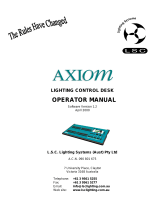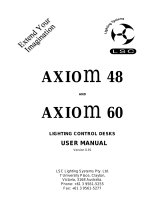
20
EUROLIGHT LC2412
8. DIMMER CONTROL
Theatre Technology, Inc.). Since virtually all modern equipment
uses this standard (even if it is done with partially different plug-
in connectors), your EUROLIGHT LC2412 is therefore extremely
flexible in how it can be implemented.
A big advantage of digital control is its enourmously simplified
cabling, since you only need one single cable for transmitting
control data. This sets the DMX system apart from its analog
conterparts, which need an extra control cable for each individual
channel. Another big advantage is made possible by the freely
addressable receivers, which is done by menas of software.
You can therefore save yourself from having to painstakingly
lay cables each time you wish to assign a particular dimmer to a
different channel. Additional information on this subject can be
found in chapter 8.2.2.
Interface format (EIA-485)
The DMX512 standard uses the RS485 interface standard for
data transmission, well-known for its impunity to interferrence.
The data are serially transmitted in the asynchron fashion at a
transmission rate of 250 kBit/s, successively for each of the
connected dimmers (up to 512 channels). The more dimmers are
connected, the longer the time interval until the next command on
this channel.
+ It is advisable to limit the number of deployed
channels in order to ensure a maximum refresh
rate. Therefore, do not use more channels than
you actually need.
In combination with the DMX512 standard, you can run up to
32 loads on a single sender (LC2412). One load responds to one
DMX512/RS485 receiver, for example, the way it is implemented
in the EUROLIGHT LD6230 dimmer pack. The number of channels
that a receiver can process is theoretically not limited, but our
LD6230 features six dimmer channels for practical purposes.
If you wish to run more than 32 loads, we recommend using
level translaters and/or signal splitters.
8.2.2 Assigning DMX channels (softpatch)
Softpatch means: you can assign up to three freely selectable
DMX channels to a console channel.
+ Each of the DMX channels can be assigned to only
one fader. Otherwise, contradicting commands
would be given with various fader settings.
To make the capabilities of the DMX512 as well as the
capabilities of the LC2412 transparent, we have to draw a clear
distinction between three different kinds of channels:
Console channels
The channels of your LC2412 (= 24+2 channels) are 26 routes
through which you can send commands. This in no way means
that you can only control 24 lighting elements.
Dimmer channels (dimmer loops)
Dimmer packs represent the power section of a light control
system, comparable to power amplifiers of a PA installation in
the audio field. Each dimmer channel is assigned to one DMX
channel, that is, it can receive commands from only one channel.
The BEHRINGER EUROLIGHT LD6230 dimmer pack features six
dimmer loops to which six six DMX channels can be assigned.
Each dimmer loop can muster a maximum load of 2.3 kW.
Therefore, you can connect multiple laps, reflectors etc to each
dimmer loop.
DMX channels
A DMX channel consists out of one digitally transmitted
information unit (1 Byte/8 Bit), whereas 256 different information
units can be transmitted. These units are transmitted sequentially,
that is, channels 0 and upwards on the sender are accounted
for, and the respective information units are assigned. The
sequence then starts anew at the next channel. In the worst-
case scenario (all 512 channels are in use) the refresh rate has
the value of 44.1 Hz. You can derive from this that it is advisable
to only use as many channels as you actually need.
Since there are 24 channels with adjustable illumination (to
each of which 3 DMX channels can be assigned), there is a total
of 72 DMX channels that can be laid out. Additionally, there are
two special channels, each of which can switch a maximum of
2 DMX channels on and off.
To assign the desired DMX channels to individual console
channels (or to preview the assignment of channels), go through
the following steps:
1. Press the UTILITY 2 key.
Fig. 8.2: Display DMX Patch 1
2. Select DMX PATCH using the SOFT A key.
Fig. 8.3: Display DMX Patch 2
The console channel is shown in the top left portion of the
menu. The connected DMX channels are shown to its right
(standard setting is 1:1. Example: Console channel 01 is
connected to DMX channel 000, console channel 08 is connected
to DMX channel 07, etc.).
The DMX channel is shown in the lower left line; its status is
shown next to it (NU = Not Used or USE 1...512). In our example
DMX channel 000 is connected to console channel 01.
3. Use the Flash keys to first select the console channel to
which you wish to assign a DMX channel (channels13 - 24:
switch to upper mode, SPECIAL 1 (channel 25) and SPECIAL2
(channel 26) by pressing and ).
4. Select a DMX channel usign the DATA wheel.
If this DMX channel is already occupied, this will be shown in
the display together with the respective console channel
number. Select the console channel (FLASH key), and select
OPEN (SOFT B key). Start again at step 3. Alternatively,
you can also select a different DMX channel.
5. Press the SOFT A key (CONNECT option) and connect the
console channel with the DMX channel. If you wish to connect
multiple DMX channels with the same console channel, simply
select an additional DMX channel and proceed with the
connection as previously described.
6. Use the QUIT key to go back to the main menu.
Connecting channels 1:1 (one-to-one) or disengaging all
connections
1. Perform steps 1 and 2, as described under 8.2.3.
2. Press the SHIFT key .
Fig. 8.4: Display DMX Patch 3
4. Now, select ALL CLEAR using the SOFT B key to disengage
all connections. Use SOFT A to go back to the standard
setting, ALL 1:1.





















